
Technical Report NTB 82-03
The Long-Term Stability of Cement and Concrete for Nuclear Waste Disposal under Normal Geologic Conditions
The nuclear power industry which has developed in this century has raised new and interesting issues in the management and disposal of radioactive waste materials. The treatment and disposal of radioactive waste involve both environmental considerations and technical processing problems. The increasing emphasis upon environmental considerations as they relate to nuclear wastes has focused additional attention upon the long-term stability of cement and concrete for nuclear waste disposal under potential geologic repository conditions.
Brief descriptions of scientific background to cement and concrete, and discussions related to the stability of structure, corrosion of reinforcement, possible environmental conditions in a potential repository site in Switzerland, and the influence of environment on cement and concrete are presented. More emphasis is placed on the thermal and pressure environment, and the effect of groundwater in a reducing environment.
The cement compositions for the immobilization of radioactive wastes are briefly commented upon from the standpoint of the cementing mechanism for compatibility with radioactive wastes, leachability, and chemical and mechanical durability.
Long-term stability of concrete based on chemical change, structural behaviour and mechanical integrity is considered during the period of 0 – 100 years and the period of 102 – 104 years. Included are suggestions for future work, which would provide vital information for predicting more accurately the long-term behaviour of cement and concrete used in the repository environment.
The following conclusions of this review provide a basis for general considerations on the selection of cement and concrete for nuclear waste disposal:
- Cement should be of a sulphate-resisting and low-heat type with a relatively high C2S content. This will reduce the risk for thermally induced cracks during construction. The long-term durability and strength tend also to be higher for this type of cement.
- The aggregate with high strength and low permeability must not contain minerals which react with cement paste and form detrimental products under high pressure and temperature.
- The water-cement ratio should preferably be as low as possible since it influences the gel-pore structure of the concrete and has a significant effect on the stability and durability of the concrete.
- The use of admixtures and additives should be avoided unless their effects on the long-term stability of cement and concrete are exactly known. Many additives have multiple effects and great care is required to select an optimum additive for specific application in repository site.
- The composition of concrete mix should be carefully selected for producing a dense, high quality concrete permitting a minimum of infiltration by groundwater and strict requirements must be established on the construction of concrete for maintaining its integrity for very long time periods.
- Cement can also be used for the solidification of low-level, intermediate-level and aged high-level radioactive wastes. Advantages of cement include inexpensive raw materials, low processing temperatures and process simplicity. Concrete waste forms show relatively acceptable thermal, chemical, physical and radiolytical stability.
